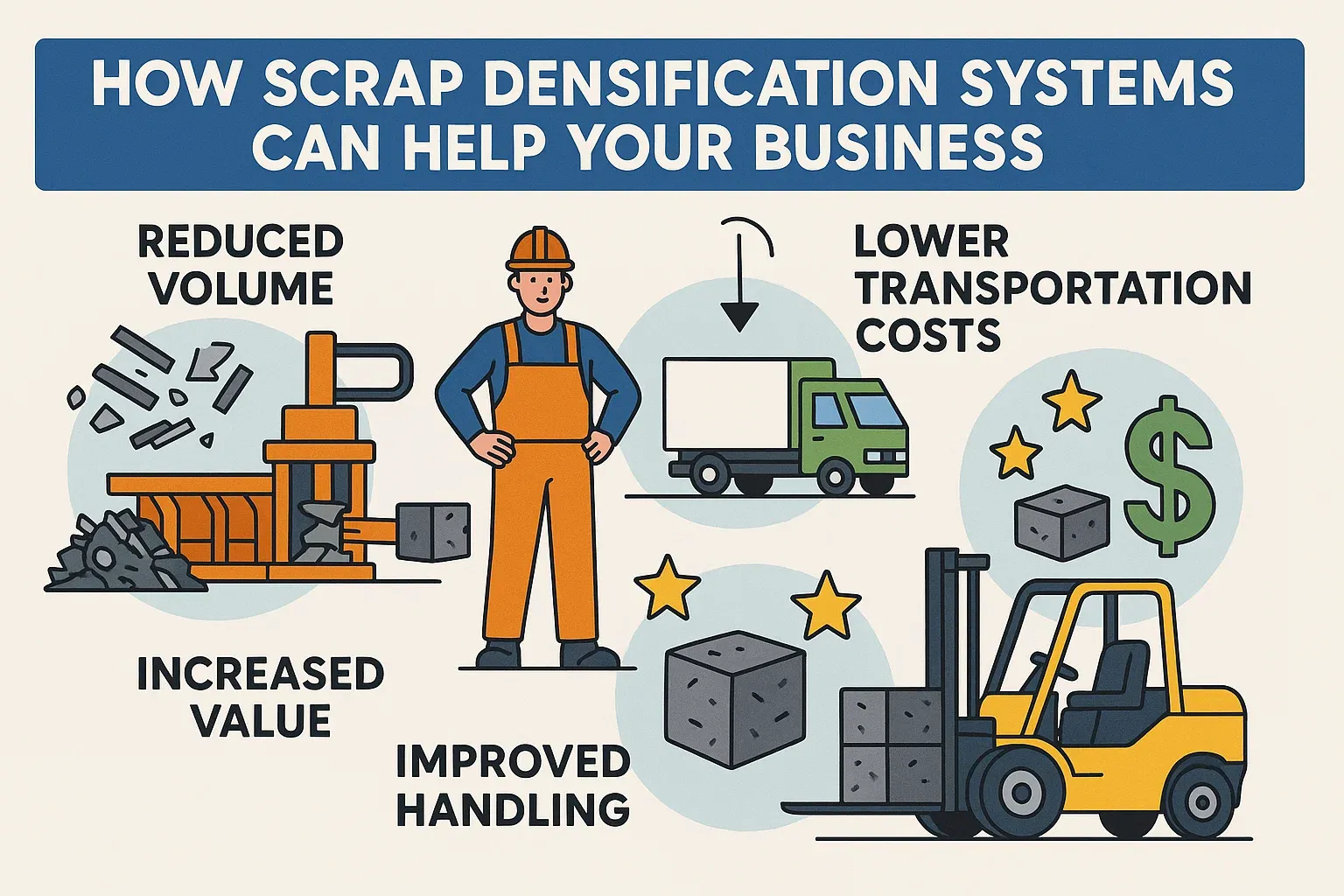Systemy zagęszczania złomu odgrywają kluczową rolę w poprawie wydajności operacyjnej i rentowności w branży recyklingu i produkcji. W przypadku przedsiębiorstw przetwarzających znaczne ilości materiałów odpadowych, takich jak tworzywa sztuczne, pianka, wióry metalowe lub odpady papierowe, wdrożenie systemu zagęszczania może mieć charakter transformacyjny.
Czym jest system zagęszczania złomu?
System zagęszczania złomu to sprzęt przemysłowy zaprojektowany do zagęszczania lub kompresowania złomu w gęstsze formy, zazwyczaj peletki, brykiety lub bloki. Zmniejsza to objętość, upraszcza obsługę i znacznie zwiększa wydajność późniejszych procesów recyklingu lub utylizacji.
Kluczowe zalety systemów zagęszczania złomu
Zwiększona efektywność wykorzystania przestrzeni
Jedną z najbardziej bezpośrednich zalet zagęszczania jest znaczne zmniejszenie wymaganej przestrzeni magazynowej. Luźne odpady są duże i trudne do przechowywania. Kompresując te materiały, firmy mogą odzyskać cenną przestrzeń roboczą, usprawnić logistykę magazynową i zmniejszyć zatłoczenie magazynów.
Oszczędności kosztów transportu
Koszty transportu mogą znacząco wpłynąć na rentowność. Systemy zagęszczania kompresują złom do gęstszych form, drastycznie zmniejszając objętość transportu i umożliwiając cięższe, bardziej opłacalne ładunki. Oznacza to mniej podróży, niższe koszty paliwa i mniejszy ślad węglowy.
Ulepszona obsługa materiałów
Materiały skompresowane, takie jak brykiety lub peletki, są łatwiejsze i bezpieczniejsze w obsłudze w porównaniu do luźnego złomu. Stanowią one mniejsze ryzyko dla pracowników, upraszczają procesy obsługi mechanicznej i zwiększają ogólne bezpieczeństwo operacyjne.
Zwiększone przychody z recyklingu
Zagęszczony złom zwykle osiąga wyższe wartości rynkowe niż materiał luzem ze względu na zwiększoną gęstość i łatwość obsługi dla recyklerów. Firmy mogą negocjować lepsze ceny i zwiększać marże zysku ze sprzedaży materiałów złomowych.
Zrównoważony rozwój środowiska
Wdrożenie systemu zagęszczania złomu wzmacnia inicjatywy zrównoważonego rozwoju poprzez minimalizację objętości odpadów, zmniejszenie wykorzystania składowisk i zmniejszenie emisji związanych z transportem. Firmy zaangażowane w zielone inicjatywy mogą znacząco skorzystać na integracji zagęszczania ze swoimi operacjami recyklingu.
Przebieg pracy typowego systemu zagęszczania
Oto uproszczony przepływ pracy:
- Podawanie materiału: Luźne materiały odpadowe są podawane do jednostki zagęszczającej za pomocą przenośników lub ręcznie.
- Zagęszczanie: Materiały są ściskane pod wysokim ciśnieniem.
- Chłodzenie (jeśli konieczne): Niektóre systemy mogą obejmować stopnie chłodzenia służące szybkiemu krzepnięciu materiałów.
- Wyjście: Skompresowane brykiety, peletki lub bloki opuszczają system w celu składowania lub transportu.
Wybór właściwego systemu zagęszczania złomu
Wybór właściwego systemu wiąże się z oceną konkretnych potrzeb Twojej firmy:
- Typ materiału: Systemy są projektowane inaczej dla tworzyw sztucznych, metali lub pianki. Wybierz sprzęt zoptymalizowany pod kątem Twojego głównego rodzaju złomu.
- Wymagania dotyczące pojemności: Dopasuj przepustowość sprzętu do dziennej produkcji odpadów, aby utrzymać wydajność.
- Łatwość integracji: Należy wziąć pod uwagę systemy kompatybilne z istniejącymi liniami recyklingu lub produkcji, aby zminimalizować zakłócenia.
- Koszty operacyjne: Oceń zużycie energii, wymagania konserwacyjne i całkowity koszt posiadania.
Porównanie wydajności: Luźny złom kontra zagęszczony złom
| Czynnik | Luźny złom | Zagęszczony złom |
|---|---|---|
| Miejsce do przechowywania | Wysoki | Niski |
| Koszt transportu | Wysoki | Niski |
| Radzenie sobie z trudnościami | Wysoki | Niski |
| Wartość rynkowa | Niski do umiarkowanego | Wysoki |
| Wpływ na środowisko | Wyższy | Niżej |
Wniosek
Inwestowanie w system zagęszczania złomu zapewnia namacalne korzyści operacyjne, ekonomiczne i środowiskowe. Dla przedsiębiorstw przetwarzających znaczne ilości złomu technologia ta jest strategicznym krokiem w kierunku większej wydajności, zrównoważonego rozwoju i rentowności.



